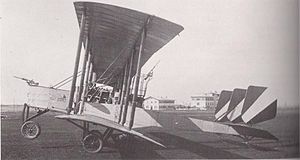Caproni Ca.33
| Caproni Ca.33 | |
|---|---|

| |
| Role | Bomber |
| Manufacturer | Caproni |
| Introduction | Autumn 1916[1] to June 1917[2][note 1] |
| Primary users | |
| Number built | see chart |
| Variants | Ca.34, Ca.35, Ca.36, Ca.36S, Ca.37 |
| Wingspan | 22.2 m (72 ft 10 in) [4][5]-22.7 m (74 ft 6 in)[1] |
| Engine | 3×150hp Isotta Fraschini V4A/B |
| Armament | nose flexible Revelli MG and 1-3×rear flexible Revelli MG[6] 450 kg (1,000 lb)[4][5] of bombs |
| Crew | 4 [6] |
| Max Speed | see chart |
| Climb | see chart |
| Ceiling | 4,100 m (13,400 ft) [4] |
| Endurance | see chart |
The Caproni Ca.33 was the first in the series of Caproni Ca.3 bombers. Italian airfields could be pretty rough, so the undercarriage was strengthened and skids were added. Two pilots sat in tandem with a gunner/observer in the nose and another in a cage above the pusher propeller. Ca.3 aircraft were built from late 1916 though 1918, and they served with a dozen squadriglia and one Italian naval unit, with some still in service at the Armistice.[7]
The name Ca.450 is sometimes used to refer to these 450hp aeroplanes.[2]
A combination of production problems and indecisiveness of the Italian military limited the Ca.3's success. The military had gotten interested in S.I.A. bomber designs, all based on yet-to-be-delivered engines, and halted Ca.3 production. The promised engines never materialized and the S.I.A. designs never flew, but restarting the Ca.3 production lines proved slow. The prototype plus 250 Ca.3s were built in 1917, with a further 20 built in 1918. Remarkably, small batches of Ca.3s (in the form of the Ca.36) were built all the way through 1926, most of them for the Italian Navy.[8]
French Production
French attempts at a license-built Caproni Ca.1 proved unsuccessful due to inadequate choices for the engines. The license-produced C.E.P.2 proved a better solution, using the same triple 150hp Isotta-Fraschini solution as the originals. Production was slow, though, and only 41 to 59 of the machines were supplied in 1917. They were supplemented by Italian-built Caproni 3's, redesignated as the CAP.2 B2. French use of the Caproni C.E.P.2 began in March 1916 with CEP 115. [9]
For more information, see Wikipedia:Caproni Ca.3.
| Variant | Speed | Climb | Endurance | Number Built |
|---|---|---|---|---|
| Italian Ca.33 | 137 km/h (85 mph) [4][1][5] [note 2] | 1,000 m (3,280 ft) in 8:00[4] 2,000 m (6,560 ft) in 24:00[1] 3,500 m (11,480 ft) in 50:00[1] 4,000 m (13,100 ft) in 40:00[4] |
3:30 [4] or 3:00-5:00[5] to ≥4:00[1] | 160[1] to 250[10]-269[7][11] to 271[8] [note 3] |
| French C.E.P.2 | 120 km/h (75 mph)[12] | 1,000 m (3,280 ft) in 8:00[12] 4,000 m (13,100 ft) in 40:00[12] |
5:00 [12] | 41-59[9] |
Timeline [note 4]

Game Data
Wings of Glory
| Maneuver | Damage | Dmg Points | Max Alt. | Climb | Points |
|---|---|---|---|---|---|
| XD | B/B | 25 | 11 [13] | 6 [13] | 143 |
Blue Max/Canvas Eagles
Miniatures and Models
1:144 Scale
- Ares: WGF301A Buttini; WGF301B CEP 115; WGF301C Taramelli; WGF301D La Guardia
- Shapeways Paintable: Kampfflieger, Reduced Aircraft Factory
- Resin Kit: Sram 144/054 (company defunct)
1:285/6mm/1:288 Scale
- Shapeways: Kampfflieger, Reduced Aircraft Factory
- Cast Metal: MSD Games/Hostile Aircraft
Resources
Orthographic Drawings
References
- Notes
- Citations
- ↑ 1.0 1.1 1.2 1.3 1.4 1.5 1.6 1.7 Ferry'14, p.124.
- ↑ 2.0 2.1 Davilla Italian Vol.2, p.123.
- ↑ Davilla Italian Vol.2, p.142.
- ↑ 4.0 4.1 4.2 4.3 4.4 4.5 4.6 Lamberton, pp.226-227.
- ↑ 5.0 5.1 5.2 5.3 Rimell'90, p.27.
- ↑ 6.0 6.1 Rimell'90, p.22.
- ↑ 7.0 7.1 Munson, p.156.
- ↑ 8.0 8.1 8.2 Davilla Italian Vol.2, pp.119-121.
- ↑ 9.0 9.1 Davilla'97, p.133.
- ↑ Lamberton, p.164.
- ↑ Angelucci, p.75.
- ↑ 12.0 12.1 12.2 12.3 Davilla'97, p.129.
- ↑ 13.0 13.1 Ares Climb Rates and Maximum Altitude Table, version 1.2, Oct 2021
- Bibliography
- Dr. James J. Davilla and Arthur M. Soltan. French Aircraft of the First World War. Flying Machines Press, 1997. ISBN 0-9637110-4-0.
- James Davilla, MD, Italian Aviation in the First World War, Volume 2, Aircraft A-H. USA: Aeronaut Books, 2023. ISBN 978-1-953201-80-5
- Vital Ferry. French Aviation During the First World War. Paris: Histoire and Collections, 2014. ISBN 978-2-35250-370-5
- W.M. Lamberton and E.F. Cheesman, Reconnaissance & Bomber Aircraft of the 1914-1918 War. Great Britain: Harleyford Publications Ltd., 1962. ISBN 9780900435027
- Kenneth Munson, Bombers: Patrol and Reconnaissance Aircraft, 1914-1919. New York: The MacMillan Company, 1968, Blandford Press Ltd. ISBN 978-0753721711
- R.L. Rimell, ed., "Caproni Ca.3". Windsock International, Volume 6, № 6, November/December 1990. Great Britain: Albatros Publications Ltd. ISSN 0268-6422.
